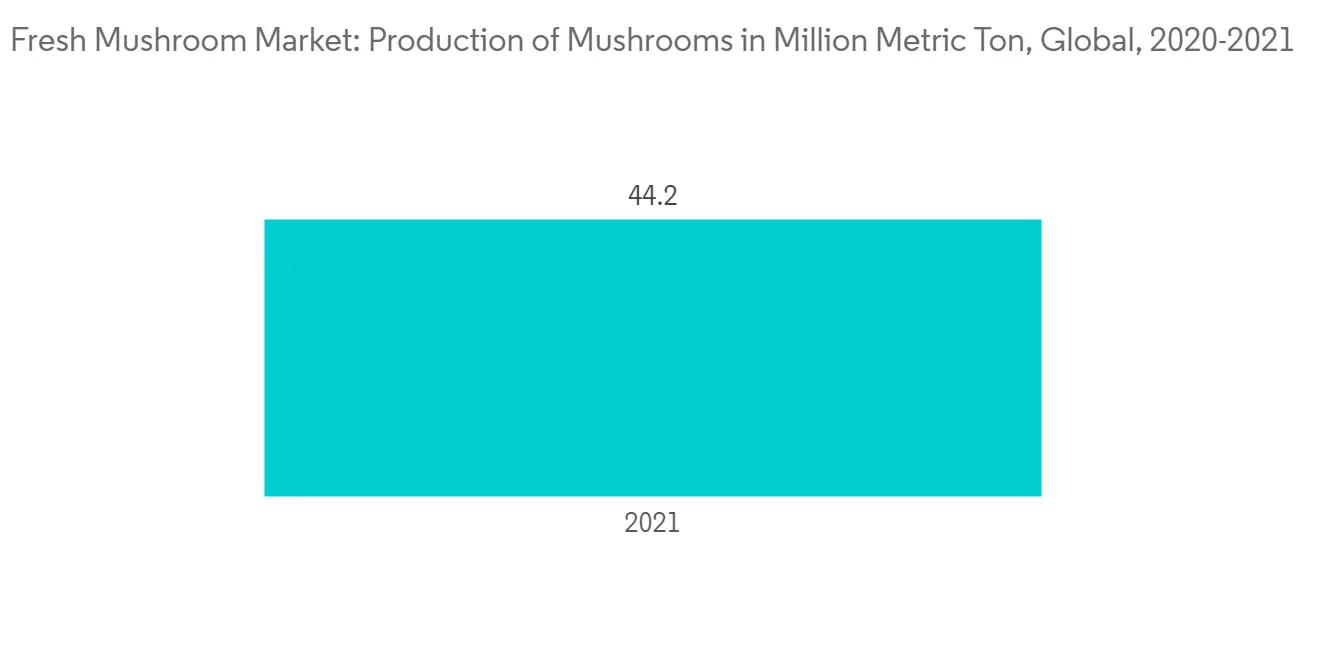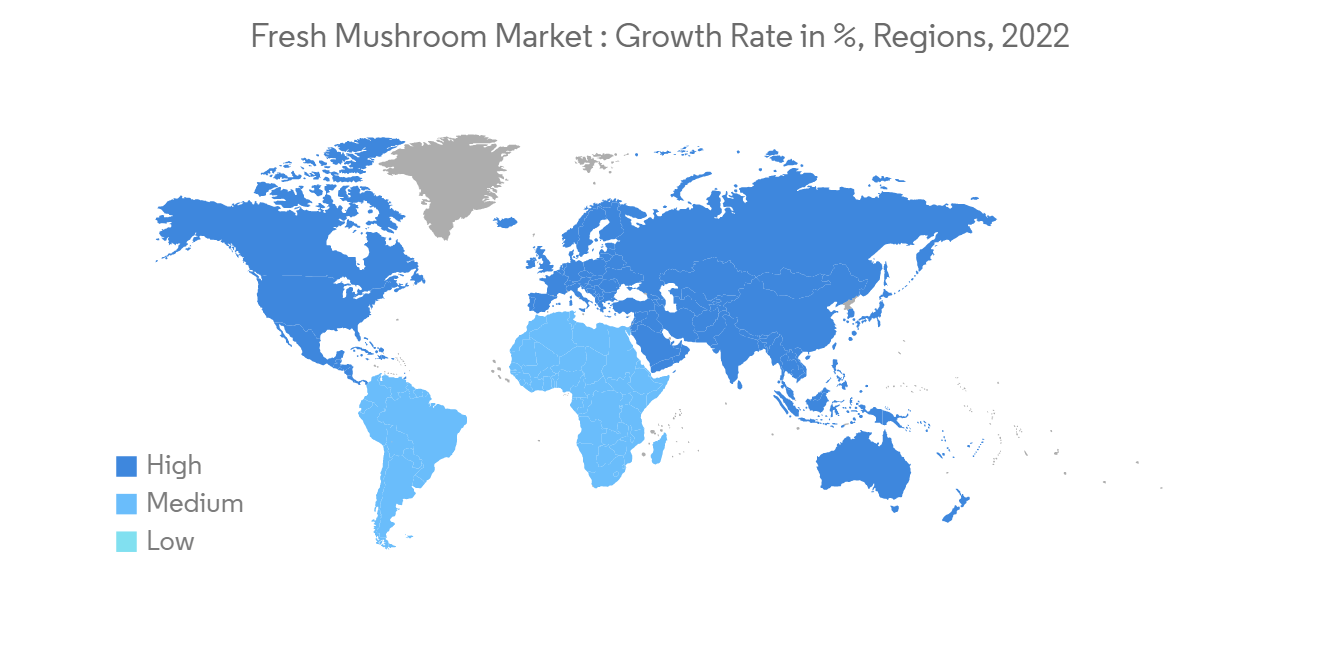 |
市場調査レポート
商品コード
1273336
生鮮キノコ市場- 成長、動向、予測(2023年-2028年)Fresh Mushrooms Market - Growth, Trends, and Forecasts (2023 - 2028) |
||||||
● お客様のご希望に応じて、既存データの加工や未掲載情報(例:国別セグメント)の追加などの対応が可能です。 詳細はお問い合わせください。
| 生鮮キノコ市場- 成長、動向、予測(2023年-2028年) |
|
出版日: 2023年04月14日
発行: Mordor Intelligence
ページ情報: 英文 79 Pages
納期: 2~3営業日
|
- 全表示
- 概要
- 目次
生鮮キノコ市場は予測期間中に2%のCAGRで推移すると予測されます。
主なハイライト
- アジア太平洋は、生鮮キノコ消費の最大市場であり、中国は世界最大の生鮮キノコの生産国です。2021年、キノコの輸出上位国はポーランドで、46万9,000米ドル相当の生鮮キノコを輸出し、カナダ、オランダがこれに続く。生鮮キノコの輸入上位国は米国で、34万8,000米ドル相当のキノコを輸入し、次いで英国、ドイツです。原動力のひとつは、微量栄養素を豊富に含み、免疫系をサポートする医療用キノコへの関心が高まっていることと思われます。ドイツ、イタリア、フランス、英国、オランダ、ポーランドは、発展途上国のサプライヤーにとって最もチャンスがある国です。
- 米国農務省によると、キノコR&Pプログラムは、既存のキノコ市場と用途を維持・拡大するために、キノコ協議会として運営されています。このプログラムは、AMSの監視のもと、同業者から推薦され、農務長官によって任命されたキノコ産業代表で構成されるキノコ評議会によって運営されています。同協議会は、米国50州、プエルトリコ、コロンビア特別区で生産または輸入される生鮮市場キノコを対象に評価額を徴収しています。平均して、年間50万ポンド以上のキノコを生産または輸入する生産者と輸入業者が査定を受けます。
- 市場の牽引役として、特に土地不足の栽培農家にとってキノコから得られる収益が高いこと、その栽培が絶大な人気を博していること、さらに消費者の観点からも、世界的に栄養価の高さから生鮮キノコの需要が高まっていることが挙げられます。
生鮮キノコの市場動向
健康志向の高まりがキノコの消費を促進する
キノコは低カロリーでありながら栄養価が高く、ビタミン、ミネラル、抗酸化物質など健康維持に重要な栄養素を多く含んでいる食品です。例えば、紫外線を浴びて育ったキノコは、骨や免疫の健康に重要な成分であるビタミンDを豊富に含んでいます。キノコは品種によって栄養価が異なります。中でもクリミニキノコは、必須微量元素である亜鉛の供給源として特に優れています。亜鉛は免疫系に不可欠な栄養素であり、乳幼児の最適な成長を保証するためにも必要です。FAOによると、世界的にキノコの恩恵が大きいため、キノコの世界生産量は2020年と比較して4,420万トン増加しました。これらの要因が消費者のキノコの需要を押し上げ、次の年も成長する傾向にあります。
2022年、カナダ政府は、カナダのキノコ部門の市場成長を支援するため、カナダキノコ生産者協会(Mushrooms Canada)に対して最大344,100米ドルの投資を行うことを発表しました。アグリマーケティングプログラムの下、資金はマッシュルームズ・カナダがキノコの栄養面での利点について消費者や利害関係者の知識を高めるために活用される予定です。このプロジェクトは、業界主導のプロモーション活動を通じて、カナダのキノコ需要と消費を国内および米国で維持・拡大することを目的としています。
菜食主義者の急増に加え、肉の代替品としての利用が増加していることから、市場の拡大が期待されています。また、コンピュータ制御、病気予測センサー、自動キノコ収穫機、自動温度制御システムなどの最新技術の進歩により、キノコ生産量は飛躍的に増加しています。このことが、今後の市場の成長を強めています。

アジア太平洋地域が市場を独占する
アジア太平洋は、生鮮キノコの最大の市場地域です。中国は、世界の生鮮キノコ生産量の52%近くを占める、生鮮キノコの最大の消費者であり生産者の一人です。アジア太平洋の他の大規模市場には、日本、インド、マレーシア、韓国が含まれます。韓国では生産者の数が多いため、国内価格が低いことが多く、同国の生産者は国際市場に活路を見出すことになります。アジア太平洋地域に次ぐ生キノコの主要生産国は、欧州、アメリカ、アフリカなどです。
海外展開のほか、主要国では、生産と包装の作業から150人以上の労働者を減らし、より短時間で大量のキノコを生産することを目的としたキノコの切断という労働集約的な工程に人工知能を搭載した機械を使って効率化を図る自動化に目を向けています。FAOによると、2021年の中国の生産量は4,110万トンを占め、前年に比べて増加しました。
日本は世界最大のマツタケ消費国であり、国内で収穫されたマツタケのほとんどを自家消費用に確保し、中国から大量に輸入しています。日本の農林水産省によると、中国の中産階級の消費者も、マツタケが持つ最大の健康効果により、ますますマツタケの味覚を獲得しています。このことは、同地域の市場が今後さらに成長するのに役立つと思われます。

生鮮キノコの業界概要
その他の特典:
- エクセル形式の市場予測(ME)シート
- 3ヶ月間のアナリストサポート
目次
第1章 イントロダクション
- 調査の前提条件と市場定義
- 本調査の対象範囲
第2章 調査手法
第3章 エグゼクティブサマリー
第4章 市場力学
- 市場概要
- 市場促進要因
- 市場抑制要因
- バリューチェーン分析
第5章 市場セグメンテーション
- 地域
- 北米
- カナダ
- 生産分析
- 消費市場の分析および市場金額
- 輸入市場の分析(数量と金額)
- 輸出市場の分析(数量と金額)
- 価格動向の分析
- 米国
- 生産分析
- 消費市場の分析および市場金額
- 輸入市場の分析(数量と金額)
- 輸出市場の分析(数量と金額)
- 価格動向の分析
- メキシコ
- 生産分析
- 消費市場の分析および市場金額
- 輸入市場の分析(数量と金額)
- 輸出市場の分析(数量と金額)
- 価格動向の分析
- 欧州
- 英国
- 生産分析
- 消費市場の分析および市場金額
- 輸入市場の分析(数量と金額)
- 輸出市場の分析(数量と金額)
- 価格動向の分析
- オランダ
- 生産分析
- 消費市場の分析および市場金額
- 輸入市場の分析(数量と金額)
- 輸出市場の分析(数量と金額)
- 価格動向の分析
- イタリア
- 生産分析
- 消費市場の分析および市場金額
- 輸入市場の分析(数量と金額)
- 輸出市場の分析(数量と金額)
- 価格動向の分析
- ドイツ
- 生産分析
- 消費市場の分析および市場金額
- 輸入市場の分析(数量と金額)
- 輸出市場の分析(数量と金額)
- 価格動向の分析
- アイルランド
- 生産量の分析
- 消費市場の分析および市場金額
- 輸入市場の分析(数量と金額)
- 輸出市場の分析(数量と金額)
- 価格動向の分析
- ポーランド
- 生産分析
- 消費市場の分析および市場金額
- 輸入市場の分析(数量と金額)
- 輸出市場の分析(数量と金額)
- 価格動向の分析
- アジア太平洋地域
- 中国
- 生産量分析
- 消費市場の分析および市場金額
- 輸入市場の分析(数量と金額)
- 輸出市場の分析(数量と金額)
- 価格動向の分析
- インド
- 生産分析
- 消費市場の分析および市場金額
- 輸入市場の分析(数量と金額)
- 輸出市場の分析(数量・金額)
- 価格動向の分析
- 日本
- 生産分析
- 消費市場の分析および市場金額
- 輸入市場の分析(数量と金額)
- 輸出市場の分析(数量と金額)
- 価格動向の分析
- 南米
- チリ
- 生産量の分析
- 消費市場の分析および市場金額
- 輸入市場の分析(数量と金額)
- 輸出市場の分析(数量と金額)
- 価格動向の分析
- ブラジル
- 生産量の分析
- 消費市場の分析および市場金額
- 輸入市場の分析(数量と金額)
- 輸出市場の分析(数量と金額)
- 価格動向分析
- 中東・アフリカ地域
- トルコ
- 生産分析
- 消費市場の分析および市場金額
- 輸入市場の分析(数量・金額)
- 輸出市場の分析(数量・金額)
- 価格動向分析
- 南アフリカ共和国
- 生産量の分析
- 消費市場の分析および市場金額
- 輸入市場の分析(数量と金額)
- 輸出市場の分析(数量・金額)
- 価格動向分析
- 北米
第6章 市場機会と将来動向
The fresh mushroom market is projected to register a CAGR of 2% during the forecast period.
Key Highlights
- Asia-Pacific is the largest market for fresh mushroom consumption, and China is the largest producer of fresh mushrooms in the world. In 2021, the top mushroom exporters were Poland, which exported fresh mushrooms worth USD 469 thousand, followed by Canada and the Netherlands. The top importers of fresh mushrooms were the United States, which imported USD 348 thousand worth of mushrooms, followed by the United Kingdom and Germany. One of the driving forces would be increased interest in medical mushrooms as they are rich in micronutrients and support the immune system. Germany, Italy, France, the United Kingdom, the Netherlands and Poland offer the most opportunities for developing country suppliers.
- According to the US Department of Agriculture, the mushroom R&P program operates as the Mushroom Council to maintain and expand existing mushroom markets and uses. The program is administered under AMS oversight by the Mushroom Council, composed of mushroom industry representatives nominated by their peers and appointed by the Secretary of Agriculture. The Council collects assessments on fresh market mushrooms produced in or imported into the 50 States, Puerto Rico, and the District of Columbia. On average, producers and importers who produce or import more than 500,000 pounds of mushrooms annually are assessed.
- Some factors driving the market are high returns generated from mushrooms, especially for cultivators with insufficient land, their cultivation is gaining immense popularity, and even from the consumer perspective, the demand for fresh mushrooms is increasing due to their nutritional value globally.
Fresh Mushrooms Market Trends
Rising Health Consciousness to Propel Mushroom Consumption
Mushrooms are a low-calorie food that packs a nutritional punch and is loaded with many health-boosting vitamins, minerals, and antioxidants, which are important parts of any diet. For instance, mushrooms raised with exposure to ultraviolet light are a good source of vitamin D, an important component in bone and immune health. Different varieties of mushrooms have different nutritional values. Among them, Crimini mushrooms are a particularly excellent source of zinc, an essential trace element. Zinc is a vital nutrient for the immune system and is also needed for ensuring optimal growth in infants and children. According to FAO, the global production of mushrooms increased by 44.2 million metric tons compared to 2020 due to the huge benefits of mushrooms globally. These factors are boosting the demand for mushrooms in the consumers and tend to grow in the following years.
In 2022, the Government of Canada announced an investment of up to USD 344,100 for the Canadian Mushroom Growers' Association (Mushrooms Canada) to support market growth for Canada's mushroom sector. Under the Agri Marketing Program, funds are being utilized to help Mushrooms Canada increase consumer and stakeholder knowledge of the nutritional benefits of mushrooms. The funded project aims to maintain and expand Canadian mushroom demand and consumption domestically and in the United States through industry-led promotional activities.
The burgeoning vegan population, combined with increasing usage as a meat alternative, is expected to fuel market expansion, and the latest technological advancements, such as computerized control, disease forecasting sensors, automated mushroom harvesters, and automated temperature-controlling systems, have also increased mushroom production drastically. This is strengthening the market to grow in the future.

Asia-Pacific Dominates the Market
Asia-Pacific is the largest market region for fresh mushrooms. China is one of the largest consumers and producers of fresh mushrooms, accounting for nearly 52% of the world's fresh mushroom production. The other large markets in Asia-Pacific include Japan, India, Malaysia, and South Korea. Due to the large number of producers in South Korea, domestic prices are often low, making the producers from the country look for opportunities in the international market. The other large producers of fresh mushrooms after Asia-Pacific include Europe, America and Africa.
Besides its overseas expansion, major countries are turning to automation to improve efficiency with machinery equipped with artificial intelligence for the labor-intensive process of cutting mushrooms which aims to reduce more than 150 workers from production and packaging operations to produce large quantities of mushrooms in less time. According to FAO, China's production accounted for 41.1 million metric ton in 2021, which has increased compared to the previous year.
Japan is the world's largest consumer of matsutake, reserves almost all domestic harvest for its own consumption and imports a large haul from China. According to Japan's Agriculture Ministry, middle-class Chinese consumers are also increasingly acquiring a taste for the mushroom due to the maximum health benefits of the matsutake mushroom. This will help the market in the region to grow further in the future.

Fresh Mushrooms Industry Overview
Additional Benefits:
- The market estimate (ME) sheet in Excel format
- 3 months of analyst support
TABLE OF CONTENTS
1 INTRODUCTION
- 1.1 Study Assumptions and Market Definition
- 1.2 Scope of the Study
2 RESEARCH METHODOLOGY
3 EXECUTIVE SUMMARY
4 MARKET DYNAMICS
- 4.1 Market Overview
- 4.2 Market Drivers
- 4.3 Market Restraints
- 4.4 Value Chain Analysis
5 MARKET SEGMENTATION
- 5.1 Geography
- 5.1.1 North America
- 5.1.1.1 Canada
- 5.1.1.1.1 Production Analysis
- 5.1.1.1.2 Consumption Analysis and Market Value
- 5.1.1.1.3 Import Market Analysis (Volume and Value)
- 5.1.1.1.4 Export Market Analysis (Volume and Value)
- 5.1.1.1.5 Price Trend Analysis
- 5.1.1.2 United States
- 5.1.1.2.1 Production Analysis
- 5.1.1.2.2 Consumption Analysis and Market Value
- 5.1.1.2.3 Import Market Analysis (Volume and Value)
- 5.1.1.2.4 Export Market Analysis (Volume and Value)
- 5.1.1.2.5 Price Trend Analysis
- 5.1.1.3 Mexico
- 5.1.1.3.1 Production Analysis
- 5.1.1.3.2 Consumption Analysis and Market Value
- 5.1.1.3.3 Import Market Analysis (Volume and Value)
- 5.1.1.3.4 Export Market Analysis (Volume and Value)
- 5.1.1.3.5 Price Trend Analysis
- 5.1.2 Europe
- 5.1.2.1 United Kingdom
- 5.1.2.1.1 Production Analysis
- 5.1.2.1.2 Consumption Analysis and Market Value
- 5.1.2.1.3 Import Market Analysis (Volume and Value)
- 5.1.2.1.4 Export Market Analysis (Volume and Value)
- 5.1.2.1.5 Price Trend Analysis
- 5.1.2.2 Netherlands
- 5.1.2.2.1 Production Analysis
- 5.1.2.2.2 Consumption Analysis and Market Value
- 5.1.2.2.3 Import Market Analysis (Volume and Value)
- 5.1.2.2.4 Export Market Analysis (Volume and Value)
- 5.1.2.2.5 Price Trend Analysis
- 5.1.2.3 Italy
- 5.1.2.3.1 Production Analysis
- 5.1.2.3.2 Consumption Analysis and Market Value
- 5.1.2.3.3 Import Market Analysis (Volume and Value)
- 5.1.2.3.4 Export Market Analysis (Volume and Value)
- 5.1.2.3.5 Price Trend Analysis
- 5.1.2.4 Germany
- 5.1.2.4.1 Production Analysis
- 5.1.2.4.2 Consumption Analysis and Market Value
- 5.1.2.4.3 Import Market Analysis (Volume and Value)
- 5.1.2.4.4 Export Market Analysis (Volume and Value)
- 5.1.2.4.5 Price Trend Analysis
- 5.1.2.5 Ireland
- 5.1.2.5.1 Production Analysis
- 5.1.2.5.2 Consumption Analysis and Market Value
- 5.1.2.5.3 Import Market Analysis (Volume and Value)
- 5.1.2.5.4 Export Market Analysis (Volume and Value)
- 5.1.2.5.5 Price Trend Analysis
- 5.1.2.6 Poland
- 5.1.2.6.1 Production Analysis
- 5.1.2.6.2 Consumption Analysis and Market Value
- 5.1.2.6.3 Import Market Analysis (Volume and Value)
- 5.1.2.6.4 Export Market Analysis (Volume and Value)
- 5.1.2.6.5 Price Trend Analysis
- 5.1.3 Asia-Pacific
- 5.1.3.1 China
- 5.1.3.1.1 Production Analysis
- 5.1.3.1.2 Consumption Analysis and Market Value
- 5.1.3.1.3 Import Market Analysis (Volume and Value)
- 5.1.3.1.4 Export Market Analysis (Volume and Value)
- 5.1.3.1.5 Price Trend Analysis
- 5.1.3.2 India
- 5.1.3.2.1 Production Analysis
- 5.1.3.2.2 Consumption Analysis and Market Value
- 5.1.3.2.3 Import Market Analysis (Volume and Value)
- 5.1.3.2.4 Export Market Analysis (Volume and Value)
- 5.1.3.2.5 Price Trend Analysis
- 5.1.3.3 Japan
- 5.1.3.3.1 Production Analysis
- 5.1.3.3.2 Consumption Analysis and Market Value
- 5.1.3.3.3 Import Market Analysis (Volume and Value)
- 5.1.3.3.4 Export Market Analysis (Volume and Value)
- 5.1.3.3.5 Price Trend Analysis
- 5.1.4 South America
- 5.1.4.1 Chile
- 5.1.4.1.1 Production Analysis
- 5.1.4.1.2 Consumption Analysis and Market Value
- 5.1.4.1.3 Import Market Analysis (Volume and Value)
- 5.1.4.1.4 Export Market Analysis (Volume and Value)
- 5.1.4.1.5 Price Trend Analysis
- 5.1.4.2 Brazil
- 5.1.4.2.1 Production Analysis
- 5.1.4.2.2 Consumption Analysis and Market Value
- 5.1.4.2.3 Import Market Analysis (Volume and Value)
- 5.1.4.2.4 Export Market Analysis (Volume and Value)
- 5.1.4.2.5 Price Trend Analysis
- 5.1.5 Middle East & Africa
- 5.1.5.1 Turkey
- 5.1.5.1.1 Production Analysis
- 5.1.5.1.2 Consumption Analysis and Market Value
- 5.1.5.1.3 Import Market Analysis (Volume and Value)
- 5.1.5.1.4 Export Market Analysis (Volume and Value)
- 5.1.5.1.5 Price Trend Analysis
- 5.1.5.2 South Africa
- 5.1.5.2.1 Production Analysis
- 5.1.5.2.2 Consumption Analysis and Market Value
- 5.1.5.2.3 Import Market Analysis (Volume and Value)
- 5.1.5.2.4 Export Market Analysis (Volume and Value)
- 5.1.5.2.5 Price Trend Analysis
- 5.1.1 North America
